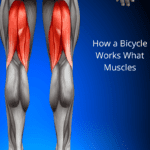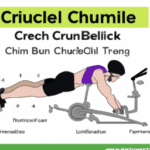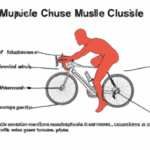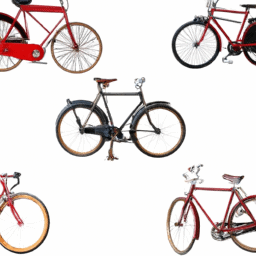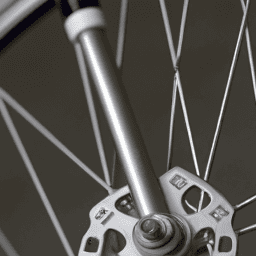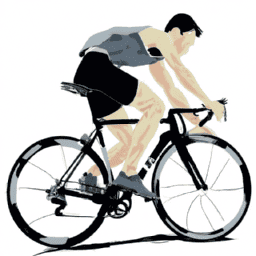I have experimented with a variety of exercise routines in search of the ideal workout that will help me achieve my desired results, including running, weightlifting, and yoga.
But one activity that has always stood out to me as a great full-body workout is cycling. In fact, I would go so far as to say that cycling is one of the best ways to work out your entire body.
Not only does cycling work your legs, but it also engages your core, back, and arms. And the best part? It’s low-impact, making it a great option for people of all ages and fitness levels.
So, if you’re looking for a fun and effective way to work out, look no further than cycling. But what specific muscles does cycling work, and how can you make the most of your cycling workout? Let’s dive in and find out.
Key Takeaways
- Cycling engages multiple muscle groups including the legs, core, back, and arms.
- The primary muscles targeted during cycling are the glutes, hamstrings, and quadriceps, while supporting muscles include the core muscles, hip flexors, and glutes.
- Targeted muscle engagement can improve power output, endurance, and athletic performance, and can also correct muscle imbalances through hill climbs and sprint intervals.
- Cycling is a low-impact exercise that is gentle on joints and can lead to significant improvements in cardiovascular health, overall fitness, and endurance.
Primary Muscles Used in Cycling
When you ride a bike, you’re not just using your legs, but your glutes, hamstrings, and quadriceps too! These are the primary muscles targeted when cycling.
The glutes, or butt muscles, are used to extend the hip while pedaling. The hamstrings, located in the back of the thigh, help to bend the knee and extend the hip. Finally, the quadriceps, the biggest muscle group in the front of the thigh, help to straighten the knee and push the pedal down.
The types of cycling you do will determine which muscles are used more. For example, when you’re climbing a hill, you’ll use your glutes and hamstrings more than when you’re cycling on a flat road. Similarly, if you’re sprinting, you’ll use your quadriceps more.
So, next time you’re cycling, pay attention to which muscles you’re using more and adjust your training accordingly.
Now, let’s talk about the supporting muscles used in cycling.
Supporting Muscles Used in Cycling
While pedaling a bike, you engage your core muscles to maintain balance and stability, in addition to using your legs to generate power. The cyclist’s posture plays a critical role in engaging these muscles effectively.
A cyclist must maintain a neutral spine to distribute the weight evenly across the pelvis. This position engages the erector spinae and rectus abdominis muscles, which help maintain a stable core while cycling. The transverse abdominis also plays a crucial role in stabilizing the pelvis and lower back, which can prevent common muscle imbalances and injuries.
In addition to the primary muscles used in cycling, several supporting muscles are also engaged while riding a bike. These muscles include the hip flexors, hamstrings, and glutes. The hip flexors are essential for flexing the hip while pedaling, while the hamstrings play a critical role in extending the hip and knee during the downstroke. The glutes also play a significant role in extending the hip and stabilizing the pelvis.
These muscles are often underutilized, leading to muscle imbalances and potential injuries. Therefore, it’s crucial to engage these supporting muscles effectively while cycling to maintain proper form and prevent injuries.
Importance of proper form will be discussed further in the subsequent section.
Importance of Proper Form
Maintaining proper form while cycling is crucial for preventing injuries and ensuring maximum performance on the bike. As someone who’s been cycling for years, I can attest to the importance of proper form. Here are some reasons why:
- Proper form helps distribute your weight evenly, which can prevent muscle imbalances and joint pain.
- Good posture allows your lungs to expand fully, which means you’ll be able to breathe more efficiently and ride longer.
- A smooth pedal stroke reduces the risk of knee pain and other joint problems.
- Proper hand positioning can prevent numbness and tingling in your hands and fingers.
- A stable core helps you maintain balance and control on the bike, which can prevent accidents.
Despite the importance of proper form, it’s easy to make common form mistakes. Some of these include hunching your shoulders, gripping the handlebars too tightly, and pedaling with your toes rather than the ball of your foot.
It’s important to be aware of these mistakes and actively work on correcting them to ensure that you’re getting the most out of your cycling workouts.
Moving forward, let’s talk about the benefits of cycling for muscle development.
Benefits of Cycling for Muscle Development
I’m excited to discuss the benefits of cycling for muscle development.
One of the biggest advantages of cycling is that it’s a low-impact exercise that puts minimal stress on joints, making it ideal for people of all fitness levels.
Additionally, cycling engages targeted muscle groups, including the glutes, quadriceps, hamstrings, and calves, making it an excellent full-body workout.
Finally, cycling regularly can increase endurance and build stamina, which can translate to better performance in other physical activities.
Low-Impact Exercise
You can work multiple muscle groups in a low-impact way by riding a bicycle. This is especially beneficial for seniors or those with joint problems who may find high-impact exercises uncomfortable. Cycling is also a great option for weight loss as it’s a cardiovascular exercise that can burn calories and boost metabolism.
When you ride a bicycle, you engage your leg muscles, including your quads, hamstrings, and calves. Your core muscles, such as your abs and lower back, also work to stabilize your body and maintain balance. Additionally, your arm muscles, such as your biceps and triceps, are used to grip the handlebars and steer the bike.
As you can see, cycling is a versatile exercise that can work multiple muscle groups while being gentle on your joints. However, if you want to target specific muscle groups for more targeted muscle engagement, there are ways to do so.
Targeted Muscle Engagement
If you want to take your cycling workout to the next level and really focus on specific areas, try incorporating hill climbs or sprint intervals. These targeted exercises can increase muscle activation and help correct any muscle imbalances you may have.
Here are some benefits of targeted muscle engagement during cycling:
- Improved power output
- Increased endurance
- Reduced risk of injury
- Enhanced overall athletic performance
By focusing on specific muscle groups during your cycling workout, you can work towards a more well-rounded and efficient ride. With improved power output and endurance, you’ll be able to take on longer rides and more challenging terrain.
In the next section, we’ll discuss how increasing endurance can lead to even greater benefits for your overall health and fitness.
Increased Endurance
Increasing endurance through cycling can lead to significant improvements in overall health and fitness. The repetitive motion of cycling engages numerous muscles, including the legs, glutes, core, and back. As these muscles become stronger and more efficient, they can work for longer periods of time without fatigue, improving stamina and endurance.
Cycling is also a great cardiovascular workout, increasing heart rate and promoting better circulation throughout the body. This can lead to improved cardiovascular health, reducing the risk of heart disease, stroke, and other related conditions.
Incorporating cycling into a regular fitness routine can provide a fun and effective way to improve overall health and fitness.
Incorporating Cycling into Your Fitness Routine
Once I hop on my bike and hit the road, I know I’m killing two birds with one stone by incorporating cycling into my fitness routine and getting some fresh air at the same time.
Outdoor cycling offers a different experience from indoor cycling. Not only do I get to enjoy the scenery, but I also get to feel the wind on my face, which adds to the overall experience. However, outdoor cycling can be challenging, especially for beginners. It’s crucial to start slow and work your way up to longer rides to avoid getting burned out or injured.
For beginners, it’s essential to have the right equipment, including a well-fitting helmet, comfortable clothing, and proper shoes. It’s also crucial to adjust the bike’s seat height to prevent knee pain and ensure a comfortable ride.
As a beginner, it’s best to start on flat terrain and gradually work your way up to more challenging routes. It’s also essential to stay hydrated and fuel your body with the right nutrition before, during, and after your ride.
With these tips in mind, I can confidently incorporate cycling into my fitness routine and enjoy all the benefits it has to offer.
Frequently Asked Questions
How does cycling specifically target and strengthen different muscle groups compared to other forms of cardio exercise?
When comparing cycling to running, cycling activates the glutes and hamstrings more while running engages the quads and calves. Muscle activation patterns vary between the two forms of cardio exercise, leading to different targeted muscle groups.
Can cycling help with muscle imbalances or injury rehabilitation, and if so, what are some recommended exercises or techniques?
As a cyclist, I’ve found that incorporating strength training exercises can help prevent muscle imbalances that lead to injury. Focusing on unilateral exercises, such as lunges and single-leg deadlifts, can aid in injury rehabilitation and balance out any weaknesses.
Are there any specific types of bikes or equipment that can enhance or target muscle development while cycling?
When it comes to bike customization, there are several options to enhance muscle development while cycling. Adding weight or resistance to your bike, or incorporating interval training into your workout routine, can help target specific muscle groups and increase overall strength.
How does cycling at different intensities or inclines affect the muscles worked and the overall muscle development benefits?
Did you know that cycling for muscle endurance can increase your overall muscle development by up to 25%? Cycling at different intensities and inclines affects the muscles worked and can provide benefits for muscle recovery.
What are some common mistakes or bad habits to avoid while cycling to optimize muscle development and prevent injury?
To optimize muscle development and prevent injury while cycling, it’s important to avoid bad habits and maintain proper cycling form. This includes keeping a steady pace, avoiding excessive leaning or swaying, and adjusting the bike’s settings for a comfortable fit.
Conclusion
Well, there you have it, folks! As someone who loves cycling, I can tell you that it’s an excellent way to work out some of your major muscle groups while having fun and enjoying the great outdoors.
By engaging your legs, glutes, calves, and core muscles, you’re able to build strength, endurance, and overall fitness. But remember, just like any other sport or physical activity, proper form is crucial to prevent injury and maximize your gains.
So, make sure you’re using the correct gear, adjusting your bike to fit your body, and paying attention to your posture and pedaling technique. It’s like riding a bike – once you get the hang of it, it becomes second nature, and you’ll be able to go further and faster with ease.
Incorporating cycling into your fitness routine can be a game-changer, both physically and mentally. It’s a low-impact exercise that’s easy on your joints, and it can also improve your cardiovascular health, reduce stress, and boost your mood.
Think of it as a breath of fresh air for your body and mind – a chance to escape the monotony of the gym and explore new roads and trails. So, grab your helmet, hop on your bike, and pedal your way to a stronger, happier you!


